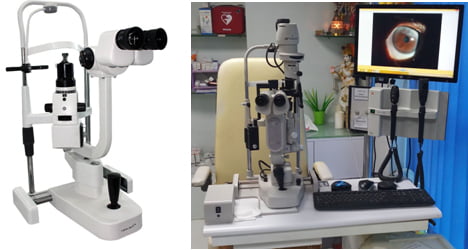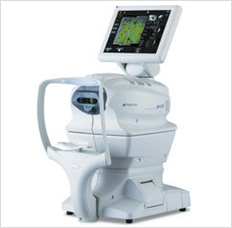CORNEA CLINIC
Anil Eye hospital is also known for its Cornea Clinic. Various types of Corneal disorders are detected and treated using the following Equipment. We have a full time specialist Cornea consultant in this dept.


High Definition Slit Lamp with Camera
Cornea Clinic Helps In:
Detection and treatment of corneal disorders with sophisticated equipments like zeiss Atlas 9000 corneal topographer.
Treatment of Corneal infections.
Treatment of Chemical injuries. for eg-acid & alkali Burns.
Advanced Specular Bio-Microscopy
Specular microscopy is a noninvasive photographic technique that allows you to visualize and analyze the corneal endothelium. Using computer-assisted morphometry, modern specular microscopes analyze the size, shape and population of the endothelial cells. The instrument projects light onto the cornea and captures the image that is reflected from the optical interface between the corneal endothelium and the aqueous humor. The reflected image is analyzed by the instrument and displayed as a specular photomicrograph.
Common ocular conditions, such as glaucoma, uveitis and Fuchs endothelial dystrophy, may produce changes in the structure and function of the corneal endothelium that result in corneal edema and visual impairment. Additionally, clinical circumstances, such as contact lens wear and intraocular surgery, may compromise the endothelium and cause corneal edema. An accurate diagnosis of endothelial disease may be the key in not only determining cause of corneal edema, but also developing a treatment plan.
Cornea Clinic

Corneal Topography
Corneal topography provides us with a detailed description of various curvature and shape characteristics of the cornea. This information is very helpful for the illustration of corneal astigmatism, detection of corneal pathologies like Keratoconus.
Pentacam
Pentacam is a rotating Scheimpflug camera system for anterior segment analysis. It measures Topography and elevation of the anterior and posterior corneal surface and the corneal thickness. Pentacam is the Gold standard for the detection and progressive evaluation of Keratoconus.
Keratoconus Treatments:
Collagen Cross Linking:
Corneal cross-linking (CXL) is an in-office eye procedure that strengthens the cornea if it’s been weakened by keratoconus, other corneal disease, or (rarely) a complication of Lasik surgery. Alternative and brand names for the procedure include corneal cross-linking, corneal collagen cross-linking, C3-R, CCL and KXL.
The minimally invasive CXL procedure involves applying liquid riboflavin (vitamin B2) to the surface of the eye, followed by treatment with a controlled application of ultraviolet light, to eliminate corneal ectasia
Anil Eye hospital provides advanced treatment of Keratoconus using Collagen Cross linking.
Cornea Clinic


Intacs for Keratoconus:
Intacs is the trademark name for micro-thin prescription inserts which were previously used as a form of refractive surgery in the treatment of low levels of myopia or nearsightedness, but has recently received FDA approval for keratoconus. Intacs are thin plastic, semi-circular rings inserted into the mid layer of the cornea. When inserted in the keratoconus cornea they flatten the cornea, changing the shape and location of the cone. The placement of Intacs remodels and reinforces the cornea, eliminating some or all of the irregularities caused by keratoconus in order to provide improved vision. This can improve uncorrected vision, however, depending on the severity of the KC, glasses or contact lenses may still be needed for functional vision.
Anil Eye Hospital uses the latest Femto Second Laser Technology in the surgical treatment of Intacs for Keratoconus.
